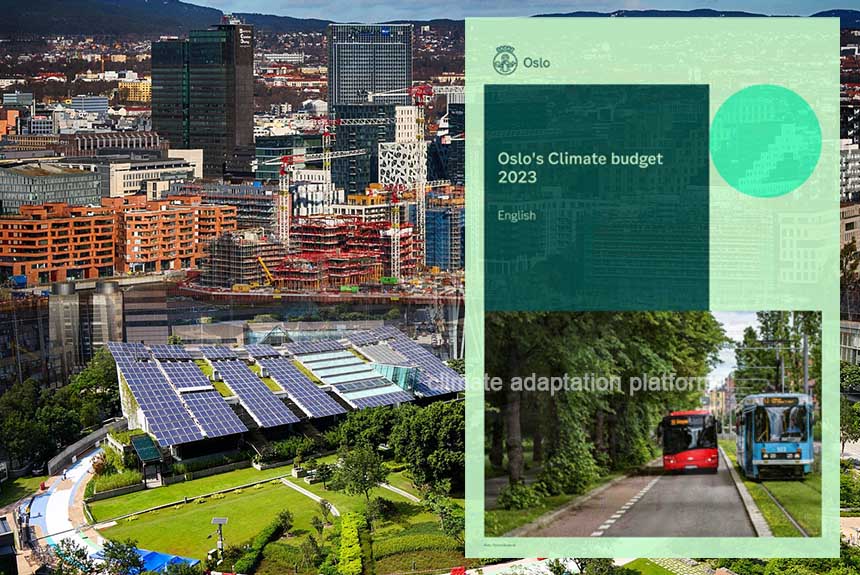Cities have a critical role in fighting climate change. At the same time, they are also a significant contributor to climate change.
Urban activities are a primary source of GHG emissions, accounting for 70% of total global CO2 emissions, with transport and buildings being among the most significant contributors.
Cities can be pivotal in reducing global GHG emissions through ambitious urban planning, robust policies, and increasing resilience or ensuring the cities can withstand the impacts of extreme weather events.
Oslo’s climate budget
Oslo, Norway, is leading the way on how cities can reduce their carbon emissions. The city launched the Climate Budget in 2017 and began tracking its carbon emissions alongside its finances.
The Climate Budget is the first of its kind and a pioneering approach to mainstreaming climate into decision-making processes, which the city considers its most important tool for achieving its climate targets. Oslo’s Climate and Energy Strategy outlines its ambitious climate goals, which include a 95% emissions reduction by 2030 compared to 2009, in line with the Paris Agreement target (Oslo’s Climate Budget, 2023).
The WRI article notes that Oslo’s Climate Budget is a novel framework that ensures accountability for GHG emissions reduction and places climate considerations at the heart of the city’s policymaking. It also allows the city agencies to share the burden of emissions reduction in a transparent, collaborative manner that is anchored within the finance department (Shin & Kustar, 2024).
“The Climate Budget was started because our politicians got tired of climate action plans that they … sent out into the bureaucracy, but then it was never really followed up,” said Heidi Sørensen, director of the Oslo Climate Agency. “They needed a governance system” (Shin & Kustar, 2024).
The city identifies the sectors with the highest emissions and prioritises their emissions. According to Oslo’s Climate Budget 2023 report, road transport, waste incineration, and other off-road diesel mobile combustions account for nearly 90% of all GHG emissions within the city. Other emissions are from waterborne navigations, closed landfill sites, and building heating. The council implemented stricter measures to cut emissions from these sources and construction projects.
Oslo is one of Europe’s fastest-growing cities, and construction is an essential component of the development of its urban areas. Thanks to the city’s climate policy, construction is on the path towards net zero using electric machinery and equipment. As a result, construction sites have become quieter and cleaner.
Although the council has set up many new initiatives, they want to highlight these four actions:
- The permit to construct a carbon capture facility at Klemetsrud.
- Reduced ticket prices for public transport, new prices in the road toll ring – the city has introduced a variable congestion charging system on a main toll road, specifically targeting diesel-powered vehicles, and exemptions for biogas and zero-emission heavy vehicles in the toll ring until 2027.
- New emission reduction targets and policies are being developed to reduce emissions from building materials. Emissions from material use in buildings and infrastructure account for up to 50% of indirect GHG emissions. Under the climate budget, the city aims to reduce GHG emissions from materials in new and refurbished buildings by 30%.
- Major initiative relating to energy production and energy efficiency: The city council takes the lead in improving energy efficiency and efforts to increase local energy production by installing solar panels on its buildings. In addition, it also increases support for energy efficiency improvements and local energy production in households and businesses.
Positive results
The WRI article notes the positive changes felt by Oslo’s’ residents borne by the city’s Climate Budget. The city’s transition to electric vehicles has also made it safer for cyclists and pedestrians. Since 2019, there have been zero cyclist and pedestrian deaths.
The city incentivises contractors to invest in electric machinery to make them competitive. It also enables the widespread electrification of public buses, trams and ferries, private delivery vehicles, and heavy-duty construction machinery. EV chargers have become more accessible to boost EV ownership.
The article says that Oslo’s climate budget continues transforming the city, prompting change in multiple sectors and improving people’s lives. Traffic has decreased, the city has become greener, and more residents have been encouraged to cycle or walk to work or destinations because the streets have become safer. As a result, 200 other Norwegian municipalities follow in Oslo’s footsteps.
“Cities are key to change. What we do in Oslo can be done in other cities worldwide, and cities together can help save the climate”, says Hallstein Bjercke, Vice Mayor for Finance in the City of Oslo.
Watch the WRI Ross Center’s s video on Oslo’s Climate Budget:
Sources:
Oslo’s Climate budget 2023. Oslo’s. Retrieved from https://www.klimaoslo.no/wp-content/uploads/sites/2/2024/01/Climate-budget-2023.pdf
Oslo’s Climate Budget. (2023 January). C40 Knowledge. Retrieved from https://www.c40knowledgehub.org/s/article/Oslo-s-Climate-Budget?language=en_US
Shin, J. & Kustar, A. (2024, July 15). Oslo’s ‘Climate Budget’ Is Building a Cleaner City. World Resources Institute. Retrieved from https://www.wri.org/insights/oslo-climate-budget



Leave a Reply